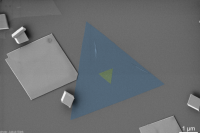Our researcher writes an article for "Nature"

Electron microscope photo of two monolayers MoS2 (molybdenum disulfide) grown on top of each other (two triangles), identical materials were used in the work with ‘Nature’, photo Jakub Sitek, from the Faculty of Physics
One of the most prestigious scientific journals in the world - "Nature" - published an article by prof. Mariusz Zdrojek from the Faculty of Physics. Our researcher was invited by the editor to comment on groundbreaking research on heat management in layered materials.
- The invitation was the result of my many years' experience in research in the field the work concerns - says prof. Zdrojek. - My article refers to the latest reports on the unique properties of 2D materials in the field of heat transport, which show the record (worldwide) properties of heat dissipation anisotropy in the nanoscale.
In his article the WUT researcher refers to the results obtained by an international research team from the United States and Sweden. They proved that changing the mutual orientation of the crystalline lattices of a two-dimensional material stacked in a multi-layer stack, significantly reduces the heat flow between these layers, while maintaining efficient heat transport in the layer plane. This phenomenon could well be described as the gigantic anisotropy of thermal conductivity, unprecedented on such a scale in the materials known to us. This discovery offers an ingenious way to control heat flux at the nanoscale.
- The control of heat dissipation is one of the greatest challenges in the design of various electronic devices and systems, particularly in view of continuous miniaturization of various electronic components - explains prof. Zdrojek.
Reducing the size of electronic components generates more heat per volume unit of the device. Overheating the device can easily result in its failure.
- If the idea of directional heat dissipation is successfully implemented, for example, in microprocessors, it could significantly increase the number of electronic components to be used in future devices susceptible to overheating - according to prof. Zdrojek.
Currently, the team from the WUT’s Faculty of Physics is applying for financing of technological equipment that is unique in the world, allowing the production of such layered materials (such as those shown in the publication) that will have the ability to dissipate heat in the selected direction. At the Warsaw University of Technology it is being successfully done on a small scale already - the photo shows an example of a grown molybdenum disulfide bilayer.
The whole article by Prof. Zdrojek is available at nature.com







